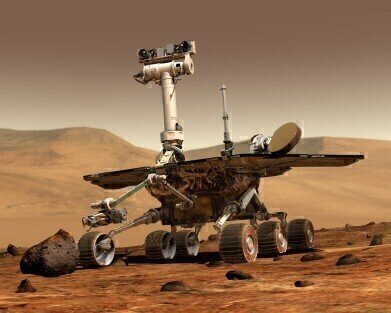News
Beagle 2 Spacecraft Found on Mars after 11 years – What Was That Again?
Jan 25 2015
Eleven years ago, the Beagle 2 probe left Earth onboard the European Space Agency’s (ESA) Mars Express spacecraft with the intention of landing on Mars' surface on Christmas day in 2003 to search for signs of life. After its ejection from Mars Express on 19 December, radio contact was lost and the probe was assumed destroyed.
However, new images from NASA’s Mars Reconnaissance Orbiter which is monitoring Mars from orbit have identified Beagle 2, revealing that it survived the landing on Mars but was unsuccessful in fully deploying its solar panels which were needed for power. While it is not yet possible for scientists to tell how many of Beagle 2's solar panels unfolded, a plan is underway to obtain sharper images.
Speaking with the Guardian, David Parker of the UK Space Agency said, “We are not looking at a crash site. We have good evidence of Beagle 2 resting on the surface of Mars. These images are consistent with the Beagle 2 having successfully landed on Mars but then only partially deploying itself.”
Glint on Mars’ surface hints at Beagle 2 in 2013
A reflection of light on Mars' surface in the general area where the probe should have landed gave scientists a first hint that Beagle 2 had been found in 2013. By November that year, Beagle 2's mission manager, Mark Simms from the University of Leicester announced that he and the Beagle 2 team were excited at the anticipation of finding the spacecraft after a decade.
“Beagle 2 trained a generation of scientists and engineers in planetary science and engineering,” said Simms.
Costing roughly £50m - a relatively inexpensive cost for a mission to mars, some of the industrial work performed on Beagle 2 was done on a cost-only basis, with other work done for free. Mark Simms explained that people wanted to buy into the mission.
What next for Mars exploration?
Beagle 2 was the smallest, most heavily-instrumented soft landing spacecraft ever produced by 2003, and the invention of the Open University professor Colin Pillinger, who gathered support and a budget for the mission. Sadly, Professor Pillinger died in May 2014 without discovering what had happened to his creation. “He would have been elated and frustrated, as I am, to have got so close. This discovery is tinged with sadness because Colin doesn’t know,” noted Mark Simms.
Next year the ESA’s ExoMars will launch, and upon arrival, will test a new landing system which was partly designed from the lessons learned from the initial investigation into the disappearance of Beagle 2. ExoMars will be part of the ESA’s astrobiology mission currently under development in partnership with the Russian Federal Space Agency (Roscosmos) to establish whether life has ever existed on Mars.
Digital Edition
Lab Asia Dec 2025
December 2025
Chromatography Articles- Cutting-edge sample preparation tools help laboratories to stay ahead of the curveMass Spectrometry & Spectroscopy Articles- Unlocking the complexity of metabolomics: Pushi...
View all digital editions
Events
Jan 21 2026 Tokyo, Japan
Jan 28 2026 Tokyo, Japan
Jan 29 2026 New Delhi, India
Feb 07 2026 Boston, MA, USA
Asia Pharma Expo/Asia Lab Expo
Feb 12 2026 Dhaka, Bangladesh



















